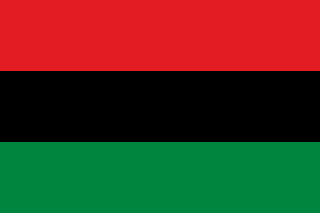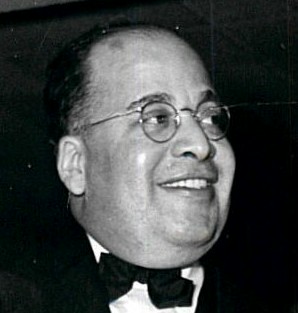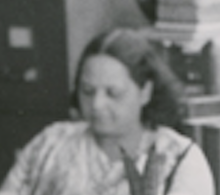Related Research Articles

The Pan-African flag—also known as the Afro-American flag, Black Liberation flag, UNIA flag and various other names—is a tri-color flag consisting of three equal horizontal bands of red, black and green. The Universal Negro Improvement Association and African Communities League (UNIA-ACL) formally adopted it on August 13, 1920, in Article 39 of the Declaration of the Rights of the Negro Peoples of the World, during its month-long convention at Madison Square Garden in New York City. Variations of the flag can and have been used in various countries and territories in the Americas to represent Garveyist ideologies.

Arturo Alfonso Schomburg, was a historian, writer, collector, and activist. Schomburg was a Puerto Rican of African and German descent. He moved to the United States in 1891, where he researched and raised awareness of the contributions that Afro-Latin Americans and African Americans have made to society. He was an important intellectual figure in the Harlem Renaissance. Over the years, he collected literature, art, slave narratives, and other materials of African history, which were purchased to become the basis of the Schomburg Center for Research in Black Culture, named in his honor, at the New York Public Library (NYPL) branch in Harlem.

Carter Godwin Woodson was an American historian, author, journalist, and the founder of the Association for the Study of African American Life and History. He was one of the first scholars to study the history of the African diaspora, including African-American history. A founder of The Journal of Negro History in 1916, Woodson has been called the "father of black history". In February 1926 he launched the celebration of "Negro History Week", the precursor of Black History Month.

John Edward Bruce, also known as Bruce Grit or J. E. Bruce-Grit, was an American journalist, historian, writer, orator, civil rights activist and Pan-African nationalist. He was born a slave in Maryland; as an adult, he founded numerous newspapers along the East Coast, as well as co-founding the Negro Society for Historical Research in New York.
John Henrik Clarke was an American historian, professor, and pioneer in the creation of Pan-African and Africana studies and professional institutions in academia starting in the late 1960s.
Joel Augustus Rogers was a Jamaican-American author, journalist, and amateur historian who focused on the history of Africa; as well as the African diaspora. After settling in the United States in 1906, he lived in Chicago and then New York City. He became interested in the history of African Americans in the United States. His research spanned the academic fields of history, sociology and anthropology. He challenged prevailing ideas about scientific racism and the social construction of race, demonstrated the connections between civilizations, and traced achievements of ethnic Africans, including some with mixed European ancestry. He was one of the earliest popularizers of African and African-American history in the 20th century. His book World's Great Men of Color was recognized by John Henrik Clarke as being his greatest achievement.

The Schomburg Center for Research in Black Culture is a research library of the New York Public Library (NYPL) and an archive repository for information on people of African descent worldwide. Located at 515 Malcolm X Boulevard between West 135th and 136th Streets in the Harlem neighborhood of Manhattan, New York City, it has, almost from its inception, been an integral part of the Harlem community. It is named for Afro-Puerto Rican scholar Arturo Alfonso Schomburg.
Jesse Edward Moorland was an American minister, community executive, civic leader and book collector.

Dorothy Louise Porter Wesley was a librarian, bibliographer and curator, who built the Moorland-Spingarn Research Center at Howard University into a world-class research collection. An African-American, she published numerous bibliographies on African-American history. When she realized that the Dewey Decimal System had only two numbers, one for slavery and one for colonization, she created space, in the Dewey Decimal System, for African American productivity.

Augusta Savage was an American sculptor associated with the Harlem Renaissance. She was also a teacher whose studio was important to the careers of a generation of artists who would become nationally known. She worked for equal rights for African Americans in the arts.

John Preston Davis was an American journalist, lawyer and activist intellectual, who became prominent for his work with the Joint Committee on National Recovery (JCNR). In 1935, he co-founded the National Negro Congress, an organization dedicated to the advancement of African Americans during the Great Depression.
John Glover Jackson was an American Pan-Africanist historian, lecturer, teacher and writer. He promoted ideas of Afrocentrism, atheism, and Jesus Christ in comparative mythology.
Willis Nathaniel Huggins was a historian and social activist. He was one of the earliest proponents of teaching African and African-American history in American schools.
The American Negro Academy (ANA), founded in Washington, DC in 1897, was the first organization in the United States to support African-American academic scholarship. It operated until 1928, and encouraged African Americans to undertake classical academic studies and liberal arts.
Levi Sandy Alexander Gumby was an African-American archivist and historian. His collection of 300 scrapbooks documenting African-American history have been part of the collection of Columbia University since 1950 as the Alexander Gumby Collection of Negroiana. Gumby was also the proprietor of a popular bookstore during the Harlem Renaissance, where he was host of a salon. Gumby's passion for collecting earned him the nicknames "The Count" and "Mr. Scrapbook".

Jean Blackwell Hutson was an American librarian, archivist, writer, curator, educator, and later chief of the Schomburg Center for Research in Black Culture. The Schomburg Center dedicated their Research and Reference Division in honor of Hutson.

Catherine Allen Latimer was the New York Public Library's first African-American librarian. She was a notable authority on bibliographies of African-American life and instrumental in forming the library's Division of Negro History, Literature and Prints.
Vanessa K. Valdés is an author, educator, writer, editor, historian, and associate professor of Spanish and Portuguese at the City College of New York. She is a Puerto Rican of African descent. She is the author of Diasporic Blackness: The Life and Times of Arturo Alfonso Schomburg. Schomburg was one of the founding fathers of Black History in North America, and the father of the Global African Diaspora. She has also written Oshun's Daughters: The Search for Womanhood in the Americas. In Oshun's Daughters she examines African Diasporic sense of womanhood, examining novels, poems, etc., written by Diaspora women from the United States, the Caribbean, and Brazil. Writings that show how these women use traditional Yoruba religion as alternative models for their womanhood differing from western concepts of being a woman.
Henry Proctor Slaughter was an American journalist, printer, and bibliographer. Slaughter collected resources that documented African American history, with a special focus on the subjects of slavery, the abolitionist movement, and correspondence from African American leaders throughout the nineteenth and early twentieth centuries. His collection of over 10,000 books and other materials now forms the Henry P. Slaughter collection at the Atlanta University Center Robert W. Woodruff Library.
The Negro in Business is a book by Booker T. Washington published by Hertel, Jenkins & Company in 1907. A copy is held by the Smithsonian National Museum of African American History and Culture and the New York Public Library's Schomburg Center for Research in Black Culture.
References
- 1 2 3 Dodson, Barnett (October 21, 1911). "Select Society for Research". The Lexington Standard. No. Vol. 17 No. 12. Retrieved 13 January 2019.
- 1 2 3 Hoffnung-Garskof, Jesse (Fall 2001). "The Migrations of Arturo Schomburg: On Being Antillano, Negro, and Puerto Rican in New York 1891-1938". Journal of American Ethnic History Journal of American Ethnic History. 21 (1): 3–49. JSTOR 27502778.
- ↑ "Who founded the Negro Society for Historical Research and what was its purpose?". Papertrell. 1911-04-08. Retrieved 2019-01-13.
- 1 2 3 4 Sinnette, E.D.V. (1989). Arthur Alfonso Schomburg, Black Bibliophile & Collector: A Biography. African American life series. New York Public Library. p. 47. ISBN 978-0-8143-2157-7 . Retrieved 2019-01-14.
- ↑ "... Discussed by Great Scholar". Pittsburgh Courier. January 13, 1912. Retrieved 13 January 2019.
- ↑ "Honoring Arturo Schomburg's Afro-Latino Legacy". The New York Public Library. 2016-07-01. Retrieved 2019-01-14.